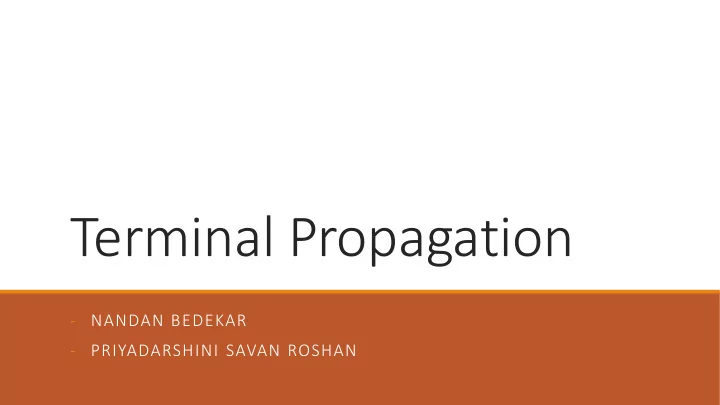

Terminal Propagation - NANDAN BEDEKAR - PRIYADARSHINI SAVAN ROSHAN
Brief Description Overview of implementation Objective ve Implementation issues Results
Brief D Descrip iption ion Algorithm for the placement of cells which targets wirelength reduction Uses recursive bi-partitioning for performing placement We have used FM algorithm – move based The results have been compared for different window sizes.
Overview o ew of i implem emen entation Locked cells were added for each partition which represents external connection to the cells. These locked cells have a fixed partition during FM algorithm and thus, aren’t moved through the passes. The terminals being propagated are limited by tuning a parameter for each circuit. Window size is varied from 0 to core width/height. When window size is maximum, no terminals are propagated (mincut). When window size is zero, all the terminals are propagated.
Overview o ew of i implem emen entation The IO cells are initially placed at the edges as specified. These IOs also act as terminals are pull the cells towards themselves. When the average number of cells in the partition reaches 50 to 100 we stop partitioning. Wirelength degradation was observed due to too much terminals being propagated. So the number of terminals propagated was limited by a threshold. Once the partitions are created, cells are assigned to rows corresponding to that partition randomly. Due to lack of time row balancing techniques were not implemented.
Implem emen entati tion I Issues KL could not be used because of its very high execution time. The runs of KL would simply not finish for circuits benchmarks with high number of cells. When the partitions in the circuit become small the number of terminals that are propagated for them become very large leading to very large cut sizes. This led to the terminals dominating cutsizes and bad partitioning. Significant challenges were faced in tuning the following parameters: window size, max number of terminals per partition, scaling factor for the max number of terminals per partition, number of steps, area constraint for the fm algorithm.
Res esults ts Runtime analysis for the complete algorithm: Name of trace file Number of cells Number of nets Runtime (in s) structP 1920 1952 25.90207601 p2 3029 3014 75.49070811 biomedP 5742 6514 2411.632531 industry2 13419 12637 2715.305205 industry3 21923 15406 2722.885562
Res esults ts Wirelength analysis for different percentage of window sizes (HPBB): Wirelength for percent window size Name of trace file 0 percent 50 percent Mincut structP 75267 73519 77441 p2 232872 229005 241483 biomedP 430287 419735 433179 industry2 1803850 1789820 1826460 industry3 3725490 3647360 3756640
WL = 75267 (WINDOW=0) WL = 73519 (WINDOW = 0.5) WL = 77441 (WINDOW = 1) Wi Wirelen elengths f for varyi ying w window s sizes es : : st structP
WL = 232872 (WIN = 0) WL = 229005(WIN = 0.5) WL = 241483(WIN = 1) Wi Wirelen elengths f for varyi ying w window s sizes es : : p2
WL = 430287 (WIN = 0) WL = 419735 (WIN = 0.5) WL = 433179(WIN = 1) Wi Wirelen elengths f for varyi ying w window s sizes es : : biom omed edP
WL = 1803850 (WIN = 0) WL = 1789820 (WIN = 0.5) WL = 1826460 (WIN = 1) Wi Wirelen elengths f for varyi ying w window s sizes es : : industry2 y2
WL = 3725490 (WIN = 0) WL = 3647360 (WIN = 0.5) WL = 3756640 (WIN = 1) Wi Wirelen elengths f for varyi ying w window s sizes es : : industry3 y3
Det etailed ed R Routi ting structP p2 biomedP
Det etailed ed R Routi ting industry2 industry3
Conclu lusion ion Terminal Propagation helps in reducing the wirelength, but the number of terminals that are propagated need to be significantly limited to get good results. Using FM instead of KL gives a significant improvement in runtime. Running big workloads with KL is not a good idea as the runs will not end. Significant tuning of parameters is required to get even better results for terminal propagation. Row balancing for detailed placement is required if there are less number of cells per row. If there are a lot of cells per row then random allocation of cells to rows takes care of row balancing. The difference is evident from the detailed placements of structP and industry3.
Recommend
More recommend